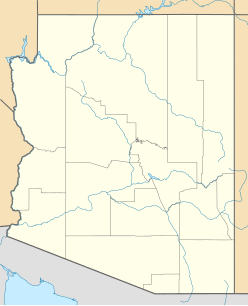Meteor Crater
| Barringer Crater | |

Meteor Crater, also known as Barringer Crater
|
|
| Impact crater/structure | |
|---|---|
| Confidence | Confirmed |
| Diameter | 1.186 kilometers (0.737 mi) |
| Depth | 170 meters (560 ft) |
| Rise | 45 meters (148 ft) |
| impactor diameter | 50 meters (160 ft) |
| Age | 50,000 years |
| Exposed | Yes |
| Drilled | Yes |
| Bolide type | Iron meteorite |
| Location | |
| Location | Coconino County, Arizona |
| Coordinates | 35°1′38″N 111°1′21″W / 35.02722°N 111.02250°WCoordinates: 35°1′38″N 111°1′21″W / 35.02722°N 111.02250°W |
| Country | United States |
| State | Arizona |
| Location of Meteor Crater in Arizona | |
| Access | Interstate 40 |
| Designated | November 1967 |
Meteor Crater is a meteorite impact crater approximately 37 miles (60 km) east of Flagstaff and 18 miles (29 km) west of Winslow in the northern Arizona desert of the United States. Because the United States Board on Geographic Names commonly recognizes names of natural features derived from the nearest post office, the feature acquired the name of "Meteor Crater" from the nearby post office named Meteor. The site was formerly known as the Canyon Diablo Crater and fragments of the meteorite are officially called the Canyon Diablo Meteorite. Scientists refer to the crater as Barringer Crater in honor of Daniel Barringer, who was first to suggest that it was produced by meteorite impact. The crater is privately owned by the Barringer family through their Barringer Crater Company, which proclaims it to be the "best preserved meteorite crater on Earth".
Despite its importance as a geological site, the crater is not protected as a national monument, a status that would require federal ownership. It was designated a National Natural Landmark in November 1967.
Meteor Crater lies at an elevation of about 1,740 m (5,710 ft) above sea level. It is about 1,200 m (3,900 ft) in diameter, some 170 m (560 ft) deep, and is surrounded by a rim that rises 45 m (148 ft) above the surrounding plains. The center of the crater is filled with 210–240 m (690–790 ft) of rubble lying above crater bedrock. One of the interesting features of the crater is its squared-off outline, believed to be caused by existing regional jointing (cracks) in the strata at the impact site.
The crater was created about 50,000 years ago during the epoch, when the local climate on the Colorado Plateau was much cooler and damper. The area was an open grassland dotted with woodlands inhabited by woolly mammoths and giant ground sloths.
...
Wikipedia

